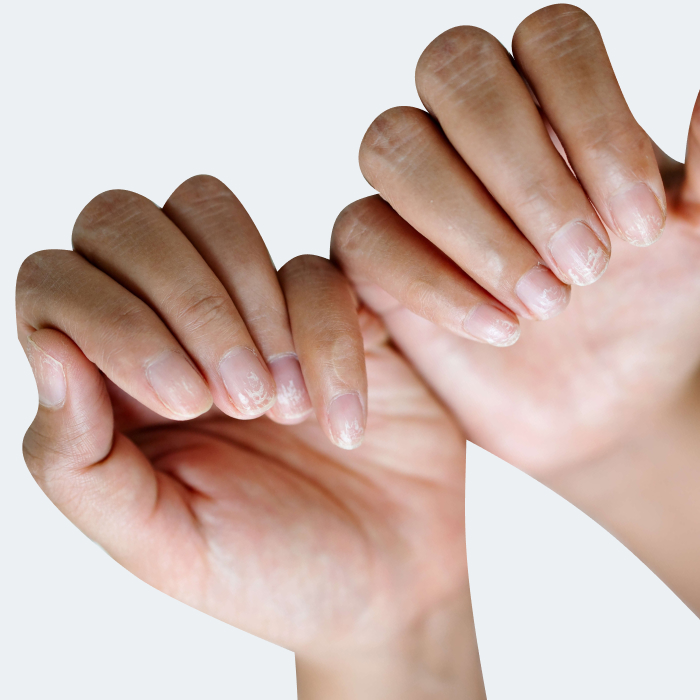Nail Disorders Treatment by
Common fungal nail infection is treatable by taking oral anti-fungal antibiotics. Nail surgery is sometimes performed when oral medication is inappropriate or fails.
Why Choose Dr. Wong Soon Tee
Friendly & Experienced Specialist
Dr. Wong connects well with his patients & he is a specialist with over 30 years of experience.
Dedicated & Focused Patient Care
Dr. Wong will manage every step of his patient’s skin healing journey.
Safe & Effective Treatments
We offer a selection of carefully curated FDA & HSA-approved treatments that give effective results.
- MBBS, Yong Loo Lin School of Medicine, Singapore
- MRCP. Member of Royal College of Physicians, United Kingdom
- FAMS, Fellow of Academy of Medicine, Singapore
- Adjunct Assistant Professor, National University of Singapore
- Visiting Consultant, University Dermatology Division, National University Hospital
- Visiting Consultant, Aesthetic Plastic Surgery Centre, National University Hospital

Nail Disorders
Fungal Infection of the Nail
This occurs when fungus infect one or more of the nails. It usually begins as a white or yellow spot under the tip of your fingernail or toenail. As the infection spreads deeper into the nail, it may cause the nail to discolor, thicken and develop crumbling edges.
Common fungal nail infection is treatable by taking oral anti-fungal antibiotics. For fingernails, it is usually 3 months’ long of treatment and it may take 6-10 months for toenails. Alternatively, an anti-fungal nail varnish can be used for milder and more superficial fungal nail infection. Nail surgery is sometimes performed when oral medication is inappropriate or fails.
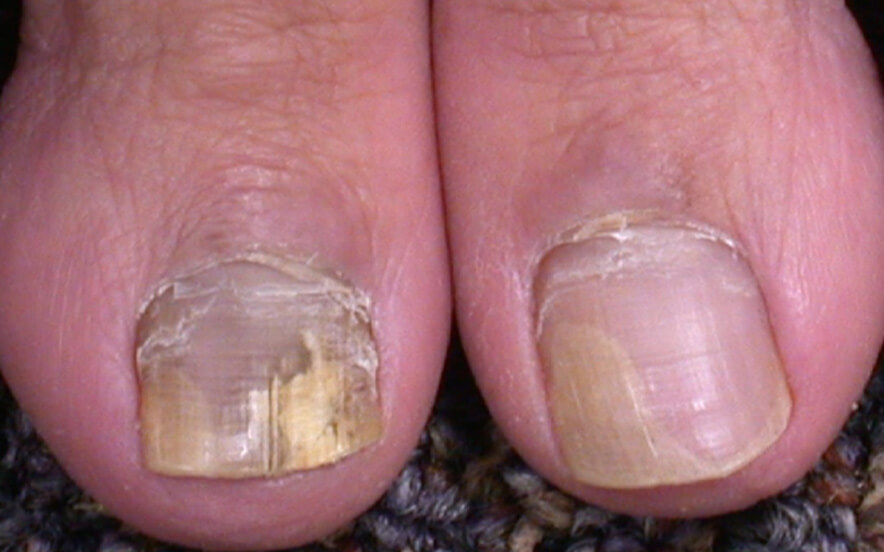
Ingrown Toenail
An ingrown toenail is a common disorder that most often affects the big toe. Initially, the side of the big toe becomes red and slightly painful with mild swelling. When an infection develops, the affected area may be swollen with pus formation and the patient may have difficulty in walking because of pain.
Treatment usually involves the use of topical and oral antibiotics and painkillers. Very often, Dr. Wong needs to surgically remove part of the ingrown nail so that the skin or infection can heal.
Periungual Warts
Warts located just next to the nail plates respond less well to treatment and have a higher tendency to recur. This is because part of the wart may be hidden underneath the nail plate and the wart is partially protected. More sessions of liquid Nitrogen treatment are required to remove such warts.
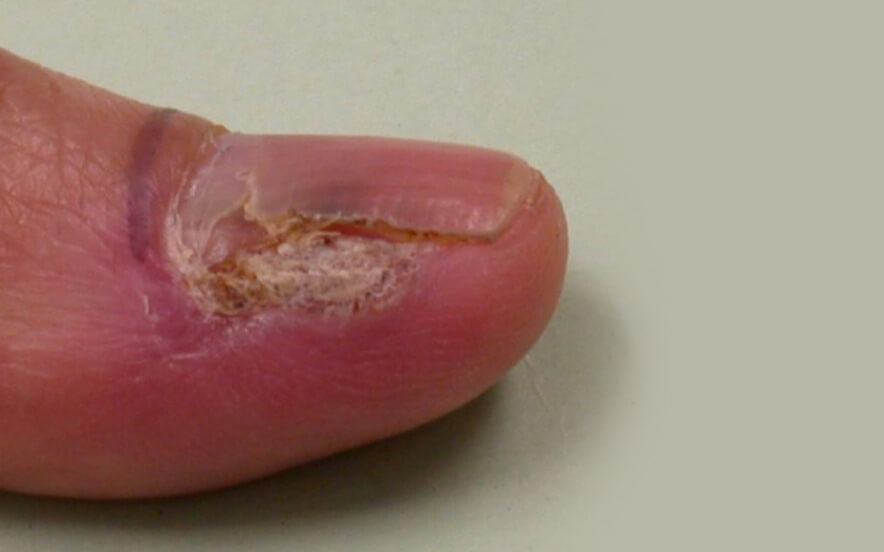
Paronychia
This is an infection of the nail fold leading to pus formation, redness and swelling around the nails. There are 2 types:
- Acute Paronychia is usually caused by bacteria. Injury to the nail folds leads to bacterial infection, resulting in a painful small abscess around the nail. Acute paronychia responds well to antibiotic treatment.
- Chronic Paronychia often has red and swollen skin next to the nail and there is also retraction of the nail fold. Retraction of the nail fold increases the inflammation because food, chemicals and germs continue to enter the space between the nail and nail fold leading to further irritation and inflammation. Chronic paronychia also needs antibiotic treatment but it is challenging to achieve complete recovery.
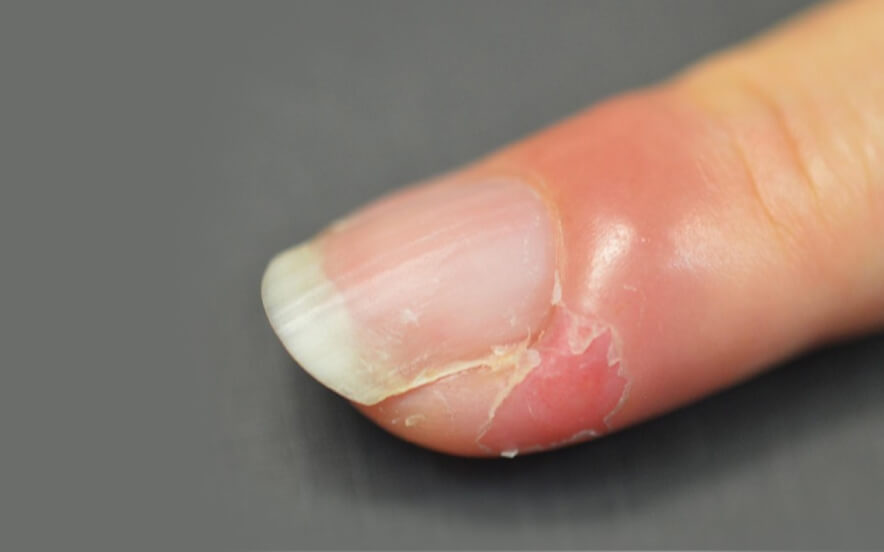
Myxoid Cyst
Myxoid cyst typically presents itself as a 4-6 mm swelling near the nail fold of the fingers or toes. It may be skin coloured, red or pearly translucent in appearance. Myxoid cyst is a pseudocyst formation. As a result of degenerative changes in the joint space of the fingers or toes, the lubricating joint space fluid leaks out and accumulates under the skin; thus, creating the pseudo-cyst. Jelly-like sticky fluid may be squeezed out from the pseudo-cyst (sometimes tinged with blood) when it is pierced with a needle.
Dr. Wong will use needle aspiration or surgical excision to remove it. Unfortunately, myxoid cysts often recur, and repeat treatment is needed.
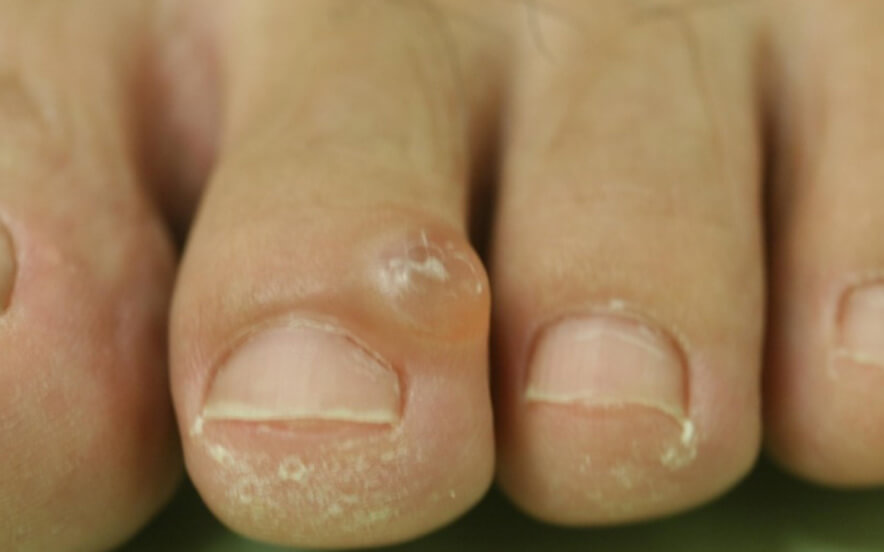
Melanonychia
Melanonychia means “black-nail”. It often appears as a diffuse brown-black patch or as a long brown-black band. Blood, melanin pigment, drugs, fungal infection and systemic diseases are the common underlying causes.
Longitudinal melanonychia usually appears as a long brown-black band on one or several nails. It is usually caused by melanocytes (pigment cells) at the nail matrix where the nail formation begins and it is a benign condition. However, patients frequently come for consultation because they are concerned about melanoma of the nail, which is a deadly skin cancer. Hence, a consultation with a dermatologist is prudent and recommended. In general, linear melanonychia does not need to be treated except for cosmetic reasons. Treatment involves surgically lifting the nail fold and the upper nail plate to expose the nail matrix. Then, Dr. Wong will shave off the pigment cells and the longitudinal melanonychia will resolve. However, scarring of the nail may occur sometimes.
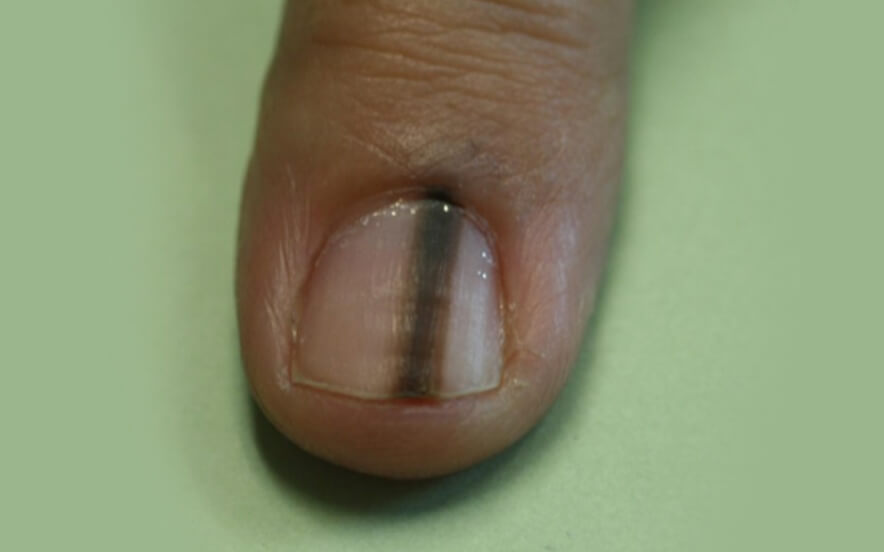
Pyogenic granuloma
Pyogenic granuloma is a relatively common lesion that presents as a painless red or blue-black growth on the nail folds. It usually grows rapidly over a period of a few days to weeks to a final size of around 1cm. Although they are benign, they can cause discomfort and bleed spontaneously and profusely.
The cause of pyogenic granuloma may be associated with the following factors: trauma, infection and hormonal changes (e.g. during pregnancy). Once diagnosed, it can easily be removed with shave excision and electrosurgery. It can recur after treatment because the feeding blood vessels remain despite the electrosurgery. Hence, it may be necessary to repeat the treatment.
Bruised nail (Subungual hematoma)
Subungual hematoma is a blood clot beneath the nail plate and commonly appears as blotchy black, dark red or even brown in color. They usually occur after an injury that leads to the leakage of blood underneath the nail.
In acute cases, the fresh blood accumulates beneath the nail and causes pain and discoloration of the nail. For patients who are unable to recall any history of trauma, they are mostly concerned about the discoloration and wonder if it could be something more serious.
If the blood clot is causing pain and discomfort, Dr. Wong can perform drainage to drain the blood and relieve the pain.
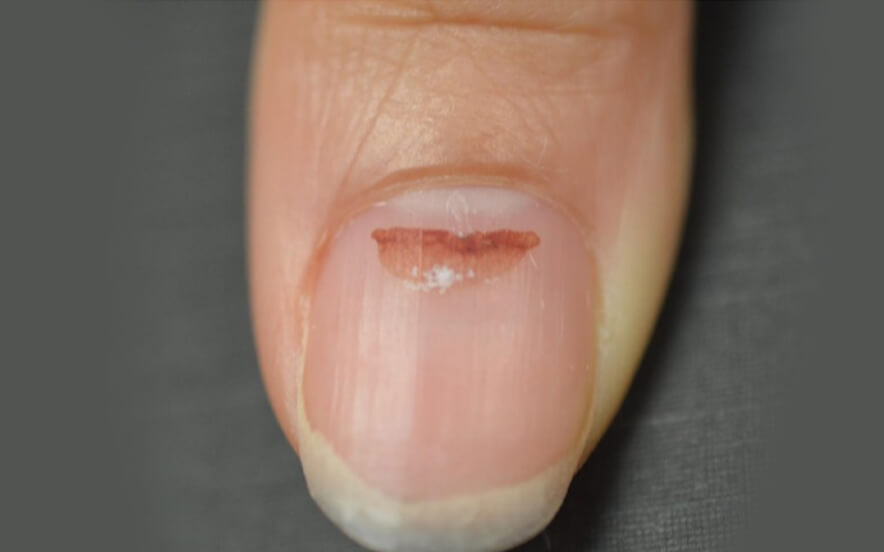
Nail Psoriasis
See Psoriasis
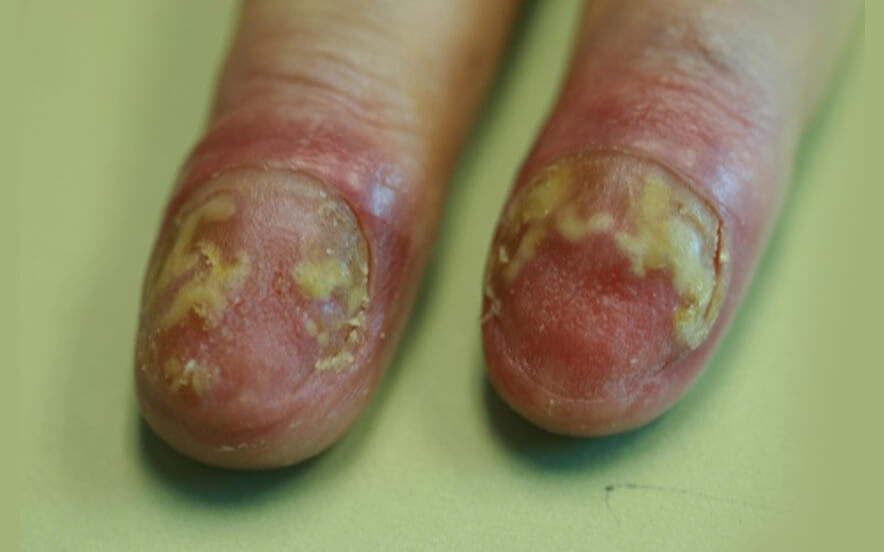
Nail tumour
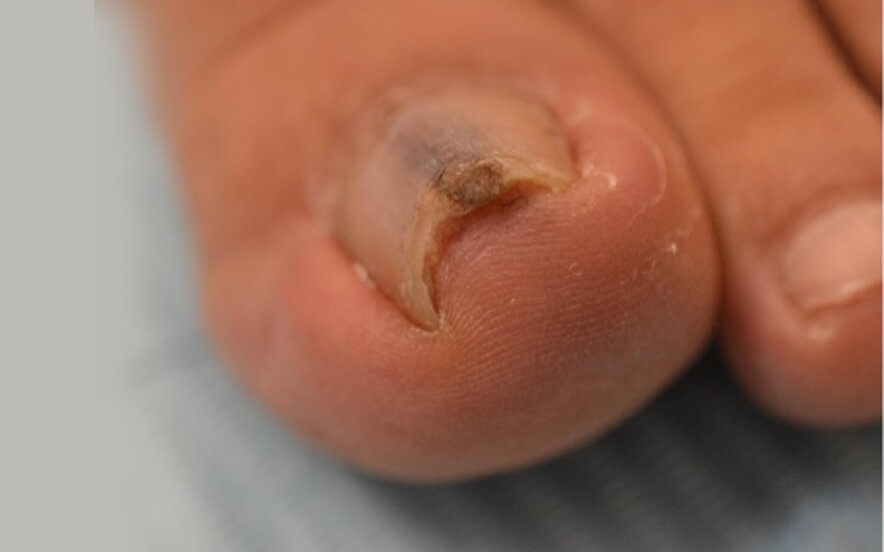
Treat Nail Problems
Dr. Wong Soon Tee is a MOH accredited Dermatologist for more than 30 years. You can consult Dr. Wong for an accurate diagnosis and optimal treatments for your nail problems.
Our Clinic Location
-
Mount Elizabeth Novena Specialist Centre
#10-22/23, 38 Irrawaddy Road,
Singapore 329563 - +65 6694 1121
- +65 9724 4911(WhatsApp)
- enquiry@assuranceskin.com
-
Mon, Tues, Wed, Fri: 9am - 5pm
Thurs & Sat: 9am - 12.30pm
Sun & Public Holidays: Closed
Book An Appointment
Leave us your details and our clinic will get back to you shortly.
For Faster Response, Call Us!
+65 6694 1121
Chat with our friendly clinic staff through Whatsapp!
